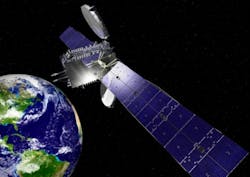U.S. Air Force, SAIC, SES, and Orbital launch Commercially Hosted Infrared Payload Sensor infrared staring system aboard SES-2 satellite
"The launch of CHIRP represents years of dedicated research, design development, and testing performed by SAIC, SMC, SES Government Solutions, and Orbital," explains Stu Shea, SAIC group president. "This program is an example for how the government can cut costs by more than 50 percent in the future by taking advantage of hosted payloads to augment missions."
The CHIRP sensor, developed by Third Generation Infrared System (3GIRS) Risk Reduction team scientists for SMC and Air Force Research Laboratory, persistently view a quarter of the Earth from geosynchronous orbit using a telescope. Its large-format focal plane array accommodates a wide-field-of-view infrared staring system to sense bright spots on the surface of the Earth that aid in the early warning of missile launches, as well as to support other military missions.
Staff at the SAIC-developed CHIRP Mission Analysis Center (CMAC) in Seal Beach, Calif., will remotely command and monitor the sensor. CHIRP sensor data will be transmitted securely to a government facility and CMAC for mission data processing and sensor evaluation.
